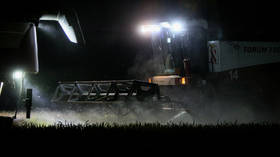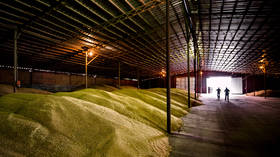Ukraine grain harvest, combat zones and a recipe for barley porridge for Europeans short on food
I could have posted this in threads on the conflict in Ukraine, but I decided to post it here, since we may hear no end of the wheat lost this year in Ukraine.
Below is a map of Ukraine, showing the major winter wheat areas. The map is from around 2000, but would not have changed significantly. While the UA production will be less this year compared with last year, so will internal consumption, as fewer people now live in what is left of Ukraine, due to war and emigration.
The next map shows the steppe zone of Ukraine.
Compare the above with the latest maps from July 9
MoD Russia report and notice the partial overlap with the zones of the conflict: The first map shows the area near Odessa and Kherson, the next screenshot shows from Nikolaev and Kherson north and east to Kharkov.
I counted the percentage of the wheat production in the areas currently held by Russia and came to about 25 %. The time now seems to be the period of harvest in some areas, as images in the above Telegram video showed. Food and energy shortages isn't happy news, so last some information about how to make cook pearl barley.
How to make barley porridge - leaning from the Russians, the Ukrainians, the Belorussians etc.
People in parts of Europe where there are sanctions against Russia, inflation and looming if not present energy shortages, may have to revert to more traditional dishes, like for instance perelovaya kasha or barley porridge. First there is a translation from the Wiki on "
Перловая крупа" or Pearl barley, which not surprising is more rich than the English, since pearl barley was common in the Soviet times.
Pearl barley is a type of barley groats in the form of smooth grains of white or slightly yellowish color, oblong or round in shape, used as the basis for side dishes and cereals, filling for soups, stews. The name is associated with the similarity of cereal grains with pearls (pearls).
For the production of cereals, grains of vitreous and semi-glassy varieties of barley are used. Whole barley grains are pre-cleaned of impurities and hulled to remove flower films, crushed to kernels, which are then ground and polished, as a result, grains of cereals are barley endosperm with minor remnants of fruit and seed coats and the aleurone layer. The resulting groats are sorted by size, in Soviet merchandising, five 'numbers' of pearl barley were distinguished by size: No. 1 and 2 - with large oval-shaped granules with a dark longitudinal groove characteristic of barley grain (passage through sieves 3.5 and 3.0 mm) , No. 3, 4 and 5 - with fine spherical grains (through sieves from 2.5 to 1.5 mm, respectively) [1] [2]. Large varieties are more often used for side dishes, small ones - for fillings and secondary fillings. At the same time, at the beginning of the 20th century, small groats were considered the most valuable (“royal”) in comparison with larger ones (“Dutch”, “semi-Dutch” and the largest “ordinary”)[3].
With energy becoming expensive, pearl barley has one minus, it requires a long time to cook, but if you soak the grains first, it will help.
It boils for a long time in comparison with other cereals - up to 1.5 hours, while the grains swell significantly, absorbing a lot of water, but retain their shape, giving a crumbly garnish (unlike another type of barley groats - barley - which is boiled into a product of a viscous consistency). The volume of barley porridge is 5-6 times greater than the initial volume of cereals, the yield of porridge from 1 kg of cereals is from 3 kg for large and up to 4.5 kg for small cereals.
Most popular in Russian cuisine, where it is usually used to make barley porridge. In the 1930s, the USSR mastered the industrial production of barley groats in significant volumes, and due to the low price and long shelf life, groats were widely used in public catering, in the diet of military personnel and prisoners. At the same time, due to the frequency of use and low cost, a stereotype of a low-value product has developed, to the point that due to the low popularity among soldiers in 2011, the product in the ration of the Russian Army was replaced in side dishes with more expensive buckwheat and rice (while left as a backfill for soups and additional dressing for canned meats).
Next, the Russian Wiki claims that the barley is common in Scandinavian cooking, but these days, I believe it is mostly found in health shops or bio-stores.
It is common in Swedish, Danish, Finnish cuisines, where it is used for side dishes, cereal sausages, as a filling in soups. In the Italian culinary tradition, there is a dish of pearl barley orzotto (English orzotto), similar in recipe to rice risotto. In British and North American cuisine, grits are less common, and are used as a secondary filling in soups, stews, stews, sometimes used to make savory puddings; in German and French cuisines it is found as an additional filling ingredient in sausages and pâtés. Among Western popular nutritionists, large pearl barley with bran residue is considered a “whole grain product” (English scotch barley) and is recommended for a healthy diet.
Since the second half of the 20th century, the production of instant pearl barley has been mastered using a steaming process similar to steaming rice[en].
A video with a Russian-speaking narrator suggests
soaking the barley overnight, cook the barley shortly for five minutes, change water and then cook the barley until it is done.
The soaking and precooking process would reduce the phytic acid element of the barley that binds to the minerals in the food, just as the
soaking period itself will reduce the cooking time, thus saving energy.
After preparing the barley, she fries some mushrooms and carrots, but if you just want the porridge, the first few minutes will do. Yes, it is in Russian, but one can auto-translate to English. As her pronunciation is clear and distinct, nothing of importance appears to be lost. Even if the video gets sanctioned or taken down, I hope my short description will do.
Как Правильно Варить ПЕРЛОВКУ. Вкусная ПЕРЛОВАЯ КАША рассыпчатая как жемчуг
(How to cook barley correctly. Delicious PEARL BARLEY PORRIDGE, crumbly like pearls)

electroverse.net





